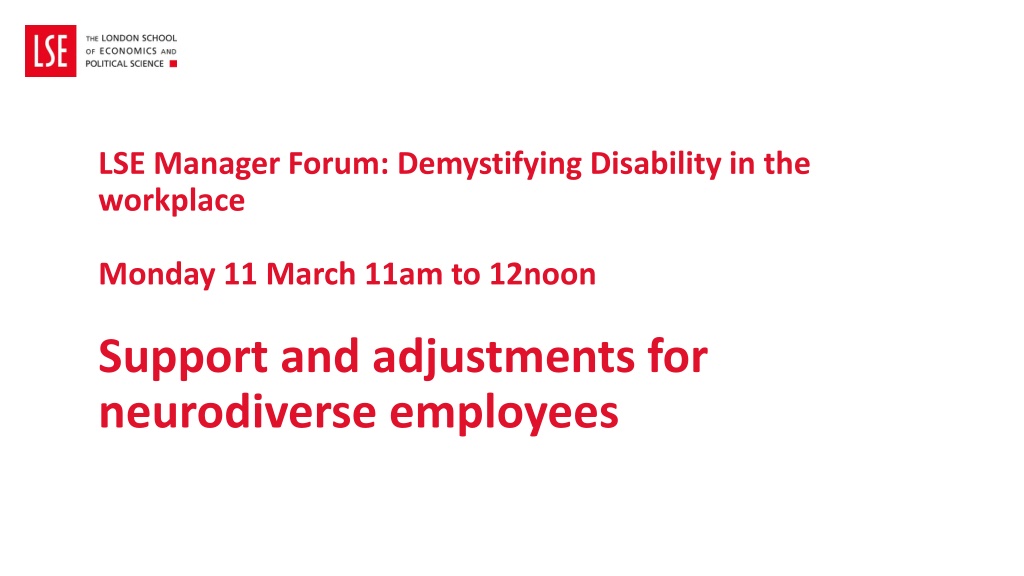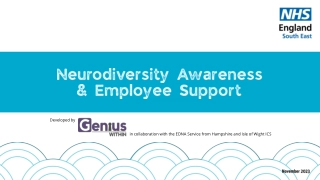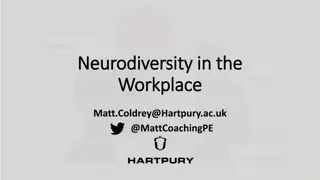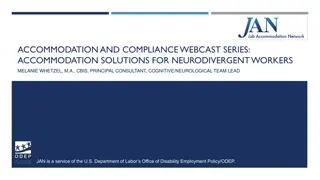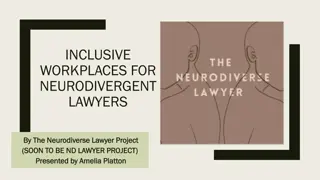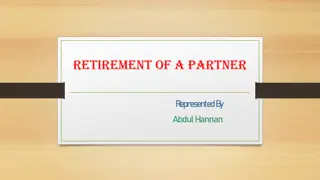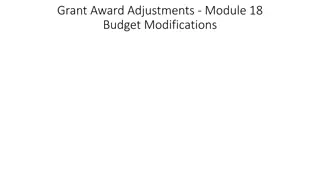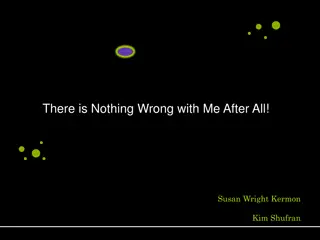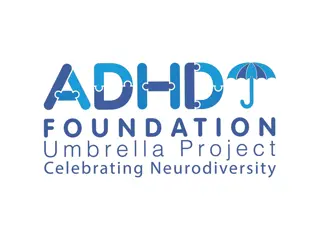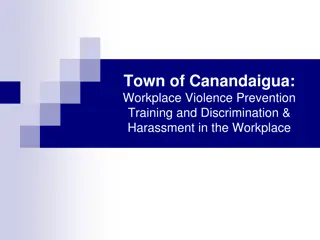Understanding Neurodiversity in the Workplace: Challenges and Adjustments
Neurodiversity encompasses various neurological differences such as ADHD, ASD, dyslexia, and more. This diversity also includes mental health conditions. Neurodiverse individuals may face memory challenges at work, requiring specific adjustments for support. Providing extra time for note-taking, simplified communication formats, and regular follow-up meetings are some common strategies to help neurodiverse employees thrive in the workplace.
Download Presentation

Please find below an Image/Link to download the presentation.
The content on the website is provided AS IS for your information and personal use only. It may not be sold, licensed, or shared on other websites without obtaining consent from the author. Download presentation by click this link. If you encounter any issues during the download, it is possible that the publisher has removed the file from their server.
E N D
Presentation Transcript
LSE Manager Forum: Demystifying Disability in the workplace Monday 11 March 11am to 12noon Support and adjustments for neurodiverse employees
Todays forum What do we mean by neurodiversity Key challenges and common adjustments for neurodiverse staff Important to remember! Resources and support available
What do we mean by Neurodiversity Neurodiversity is the umbrella term used to describe the neurological ways that people process information that are different from the accepted norm . It often runs in families, and occurs in all genders, races, cultures, socio-economic groups, and intelligence scales. The list of conditions that come under the neurodiversity label can vary, but the ones most commonly known about are: Attention deficit hyperactivity disorder (ADHD) Autistic spectrum disorder (ASD) also known as autism Dyscalculia Dyslexia Developmental co-ordination disorder (DCD) also known as dyspraxia.
Neurodiversity and Mental Health Chronic mental health conditions are also included under the neurodiverse umbrella term, such as bipolar disorder and borderline personality disorder. Many neurodiverse people are also affected by mental health difficulties. For instance, autistic people can struggle with depression and anxiety due to: Negative attitudes from others leading to trauma and loneliness. Navigating environments that do not meet sensory needs. Misdiagnosis Barriers to support
Common challenges and adjustments at work for neurodiverse employees Memory Short-term working memory is a common challenge for many neurodivergent individuals and can impact work in many ways including: Learning new skills and information Copying down information may take longer or contain mistakes Notes from meetings or conversations may miss information or contain mistakes May find it harder to follow instructions and directions some steps may be missing or in the wrong order Difficulty remembering information shared verbally such as instructions and numbers Difficulty following processes in the correct order or missing steps in the process Forgetting where they are in completing a task.
Common challenges and adjustments at work for neurodiverse employees Common adjustments for memory difficulties: Giving the person extra time to make notes they can refer back to. More regular catch-up and follow-up meetings to remind the employee what they need to do. Communicating in simpler formats, such as bullet points, checklists and flow charts. Use plain English. This can make it easier to remember information and refer back to it. Allowing the employee to use their phone while working for example, to set reminders, make notes or record conversations. Encourage the use of calendars, planners and project management tools that show deadlines. S Encourage the use of digital reminders for meetings and deadlines. Keep questions and instructions short if given verbally. May need to follow up in writing. Use images, colours and other features which can help use other senses to remember information.
Common challenges and adjustments at work for neurodiverse employees Organisation, planning and time management Difficulties may include: Judging how long a task may take Prioritising Overwhelm Common adjustments: Flexible working Allowing them to carry devices that have reminders such as a smart phone. Assistive technology, such as software that helps with time management. Setting time aside from their regular duties to set up a reference log of how long specific tasks take. Encouraging the use of digital or paper planners, colour coding, deadline reminders and visual layouts can be very useful. Scheduling admin, organisation and planning time. Project management systems and software
Common challenges and adjustments at work for neurodiverse employees Reading, writing and numeracy Difficulties may include: Tasks involving reading, writing or numeracy may take longer Accuracy issues Lack of logical structure in writing Mistakes, such as reversing 14 to 41 may be harder to notice Reading, writing and numeracy common adjustments: Allowing more time for reading and writing tasks. Providing a quiet area away from their workstation to work on tasks. Sharing documents in plenty of time ahead of meetings and training to give employees time to read and process them. Sending documents in editable format. They may need to adjust colour, font, size, and spacing to fit their individual needs.
Common challenges and adjustments at work for neurodiverse employees Focus and concentration Hyperfocus when a person may be so focused (also known as in the zone ) that they are oblivious to what is going on around them Hypo focus when a person finds it very difficult to focus on a task. In both cases, transitioning into and out of concentration can take longer than average. Concentration can be adversely affected by factors such as: Emotions such as worry, stress, excitement and enthusiasm Tiredness Illness External distractions.
Common challenges and adjustments at work for neurodiverse employees Focus and concentration impact on work: Tasks make take longer to complete. Missing deadlines. Critical information in conversations and meetings, such as decisions and actions, may be missed. More easily distracted by people, sights and sounds around the workplace. Once distracted, difficulties returning to what they were doing harder. Work may contain more errors and inaccuracies due to issues with focussing while completing it. Leaving work right up to a deadline due to belief the pressure of a close deadline helps focus. This may work, but it should be discussed with their manager as it can cause stress and risks missing deadlines.
Common challenges and adjustments at work for neurodiverse employees Focus and concentration adjustments: Encourage your team to work in their preferred ways wherever possible, for example working in quiet locations or from home. Alternatively, some may find that coming into the office more than required helps them concentrate. Assigning them a workspace in a quieter area where fewer people are likely to walk past, and away from noisier areas. Encouraging the employee to schedule different tasks for different times of day. For example, they may find it easier to do writing tasks in the morning, and short-term focus tasks in the afternoon. Provide tools to help them pace their work. Use calendars to block out time for specific tasks. Ask colleagues to respect those calendar blocks unless absolutely necessary. Reducing distractions Allow employees to use with headphones or ear plugs in to remove background noise distractions.
Common challenges and adjustments at work for neurodiverse employees Focus and concentration adjustments: Allowing employees to turn off work-related notifications (such as email, phone calls and work chats) for set periods to reduce distractions. Allowing the employee to fidget or doodle during meetings, with the understanding that this helps their concentration (though it may look like they are not focusing). Allowing the employee to take regular short breaks or short walks. This can help with pacing work and processing information. Structuring meetings to make them as focused and concise as possible. This includes having the host pause regularly for contributions as people with barriers around concentration may forget their ideas if they must wait a while to share them. Planning the timing of regular meetings to occur just after a break. They may have to concentrate to be on time, and so be unable to perform their usual duties in the run up to a scheduled meeting. Alternatively, they may hyperfocus on their work and miss the start of the meeting. Timing meetings to start just after breaks can help reduce the likelihood of this occurring. Build regular breaks into longer meetings for example, above 45 minutes. Allow some meeting attendees to be present only for the part of the meeting that is relevant to their work.
Common challenges and adjustments at work for neurodiverse employees Routine and structure: Some neurodivergent employees will need flexibility, others will need more structure Changes to established routines can cause some employees stress and anxiety for example, people with autism. Other neurodivergent people may find rigid routines difficult or impossible to work with for example, people with ADHD. Work may be lower quality or take longer if neurodiverse employees must work to routines and structures that don t work for them. Employees with conditions that affect memory may forget workplace routines and structures, especially if they are new employees or routines and structures have recently changed.
Common challenges and adjustments at work for neurodiverse employees Routine and structure supporting neurodiverse employees: Be clear about expectations Flexibility let employees set their own structures and routines as far as possible Avoid micromanaging Keep them updated as much as possible about changes include them in planning changes wherever possible or get feedback Review regularly Common adjustments for routine and structure include: Blended working Flexible working times this can help with pacing and preventing burnout. Sharing their routine with the rest of the team (if they agree). This can help prevent demands being made on their time outside their working hours, if they differ from the rest of the team s.
Common challenges and adjustments at work for neurodiverse employees Verbal communication and social interaction: Verbal communication and social interaction can be more difficult for some neurodiverse people Unclear speech, metaphors or acronyms may be confusing For those with ADHD, may find it hard to wait their turn in conversations, interrupt or change the subject abruptly For autistic people understanding unwritten social rules may be challenging, such as maintaining eye contact, making small talk or greeting / saying farewell to colleagues may be stressful. Common adjustments for communication and social interaction include: Technology, such as text-to-speech or speech-to-text software Altering meeting formats, for example to eliminate cross-talk or to have processes for deciding who should speak Allowing people to opt out of social events Encourage people to use avoid jargon and excessively metaphorical language Allow people time to process information and to reply in a way that works best for them.
Common challenges and adjustments at work for neurodiverse employees Impulsivity and hyperactivity: Impulsivity: Impulsive decisions and actions - this can be a great strength such as when there is a need for quick and decisive decision-making in emergency and fast-moving situations. Also associated with risk-taking, interrupting other people, and paying less attention to detail (unless it is a task or topic they are really interested in). Hyperactivity: This usually manifests differently in adults from the stereotypical hyperactive child. Often seen as restlessness, constant talking, getting bored easily, trying to do multiple things at once, and having a racing mind.
Common challenges and adjustments at work for neurodiverse employees Impulsivity and hyperactivity common adjustments: More regular catch ups and detailed feedback. These should include looking at workload and timescales as individuals who are prone to impulsivity and hyperactivity will often volunteer to take on new projects but not necessarily have the time management skills to match this enthusiasm Allowing use of noise-cancelling headphones or ear plugs to block noise Larger computer monitors, or multiple monitors to reduce external distractions A more private workspace or working from home some of the time to avoid distractions Being able to structure their day especially if they take prescribed medication for impulsivity and hyperactivity Have project management, organisation and planning tools that work for them Keep meetings and training sessions short or have frequent breaks. Encourage doodling and playing with desk toys as these can help control and improve concentration If interrupting is a challenge in group sessions and meetings, agree a strategy with them that can be used to reduce this. For example, suggesting that they write down points or questions in chat or on paper until it is their turn to speak.
Neuroinclusive practices at work top tips Always invite team members to optional events unless they specifically request not to be asked to certain events. This can help a person feel included in the team but give them the option of attending or not. A person may not feel comfortable attending team social events initially on joining the team but may do so in time. Some people may like to attend but don t feel comfortable contributing but will contribute later in writing or another mode. Let people know in advance what is expected so they can decide if they want to attend and if they need to ask for any adjustments. It may be helpful to have a pre-agreed silent signal to indicate if they are feeling uncomfortable such as a communication bangle where the colour on show identifies whether they want to interact. A system of silent signals help communicate to the individual that they should complete an action. These should be agreed upon in advance. For example, allow someone else to speak. This can happen if it is a subject they are passionate and very knowledgeable about.
Neuroinclusive practices at work top tips Have a break-out room for anyone who needs time-out or time to themselves. Keep sessions short so that people can go for a walk to help pace their energy levels, for example. Some people find applause is too loud and may request that people wave instead, known as flappause. Don t expect someone to do something they are uncomfortable with ask what they would like to do. For example, they may prefer monitoring the online or chat features at a conference rather than networking with people in person. Some people will find attending a whole conference difficult and prefer to attend parts of it in person. Socialising at meals and welcome events may be challenging should not need to attend all these social events in these situations.
Important to remember! Document any agreed adjustments and share with employee Reviewing adjustments is crucial to success Not all neurodiverse employees will be experts in their own condition or know what they need Diagnosis not necessary to implement adjustments and support including Access to Work Help and support is available!
Resources and support Reasonable Adjustments Pocket Guide LSE Disability Policy Consult with HR Partner or Staff Disability and Mental Health Adviser Access to Work helpline Register with the Business Disability Forum (LSE are members) to access resources including the Neurodiversity Toolkit
Resources and support Neurodiversity focussed workshops/training: Neurodiversity training for line managers 20 March 2-4pm Workplace Skills: Staying Organised, Focused, and Motivated Wed 24 April 2-3pm Demystifying ADHD: Definitions, Barriers, and Diagnostic Journey Wed 8 May 2-3pm Inclusion in the Workplace: What Do Reasonable Adjustments for Neurodiverse Staff Look Like? Wed 22 May 2-3pm Neurodiversity Celebration Week 2024 Events
Thank you! Thoughts/suggestions/questions? Feel free to get in touch via l.h.mu@lse.ac.uk
